The Vivekananda International Foundation (VIF) organized an important seminar ‘Vasudhaiva Kutumbakam: Relevance of India’s Ancient Thinking to Contemporary Strategic Reality’ in collaboration with the Indian Council for Cultural Relations (ICCR) and the Indian Council of Philosophical Research (ICPR) on 16 and 17 January 2019. The adoption of 21 June as International Day of Yoga by the United Nations General Assembly in 2014, in response to an India-led resolution with a record high number of co-sponsors, was a landmark event. It is important now to mobilize our ancient resources of ideas and bring them to practical and strategic use to build an Indian narrative. Each country’s outlook and approach towards the rest of the world is determined by its civilizational and philosophical heritage. The objective of the seminar was to highlight Indian civilizational resources that could be actively adopted in India’s foreign policy and strategic thinking, and at the same time, think about ways of deepening India’s already-existing cultural footprints worldwide. The aphorism ‘Vasudhaiva Kutumbakam’ is a symbol around which this quest for the Indian narrative could be rallied.

In his Welcome Address, Dr. Arvind Gupta, Director, VIF, said it was time for us to think what Indian thought has to offer to a modern world, torn apart by different kinds of conflicts, like conflicts based on linguistic, religious and ethnic identities, climate change, environmental degradation and so on. Any narrow understanding of such issues cannot promote peace. In this context of duality between self and the other, how does a narrative that emphasizes oneness, cosmic unity, morality and ethics become relevant? International Relations based on the idea that the strong should make the norm and the weak should follow has to change. The Chinese are mobilizing ancient Chinese concepts. Can the Indian concept of Vasudhaiva Kutumbakam provide an alternative framework in the form of the ideal of harmony in diversity? If one says this ideal is impractical from the point of view of international politics, then what other alternative do we have to ensure long-standing peace?
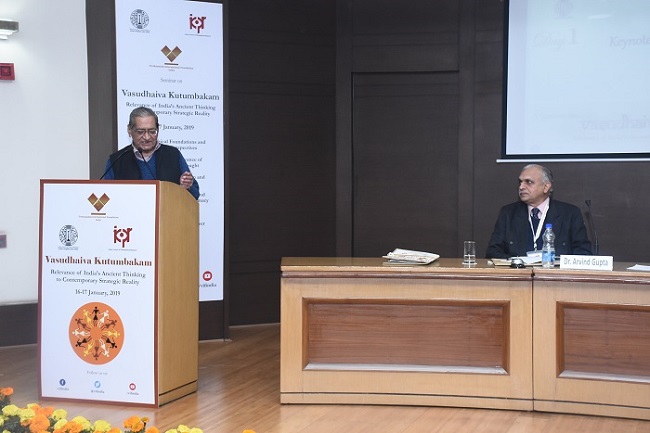
The Keynote Address was given by distinguished scholar of Indian Studies, Prof. Kapil Kapoor. He said that Indian civilization has always stood for the upholding of dharma. Furthermore, he noted that Indian culture has been a human-centered culture, unlike the Hebraic culture that was God-centered and followed commandments. Vasudhaiva Kutumbakam is an ideal that speaks of a person who bears and forbears. It points towards an interdependent, supportive, mutually inclusive system. Vasudhaiva Kutumbakam is the ideal of that person who is udaracharita—one who is large-hearted and generous in nature; in other words, one who realizes the interconnectedness of the world. The Bhagavad Gita clearly states the ideal as being able to see everyone in oneself and oneself in everyone. It is only in a state of brahmisthiti that one can feel oneness.
Prof. Kapoor further pointed out that instincts that lead man astray come naturally to him—one doesn’t have to teach anyone to tell a lie. But we have to teach people to tell the truth. So, the moment we have to contend with real human nature, the difficulty arises. In some cultures, regulations prescribed are like laws, accompanied by concepts like profit, reward or punishment. Vasudhaiva Kutumbakam is not a regulatory law in that sense. It can be considered as a maxim in the category of mahavakya. Its purpose is not imposition, but enabling understanding. When human consciousness evolves, one no longer needs impositions, because right conduct then comes naturally. The speaker pointed out another difference in approach: our Constitution today gives a prominent place to fundamental rights, whereas duties are relegated to the status of Directive Principles, whereas Indian culture has always been duty-centric. Rights are conflictual, duty is harmonizing. Our modern education system in a way goes against our own culture.

The first session of the seminar dealt with the Philosophical Foundations of Vasudhaiva Kutumbakam and Historical Perspectives related to it. Prof. S R Bhatt, Chairman, ICPR, opened the session with his observations on how Vasudhaiva Kutumbakam helps us move towards a different conceptualization of ‘Other’—from an “I-Thou” approach to an “I-We” approach. Should we talk in terms of clashes of civilizations or harmony of civilizations? There can be two possible approaches, namely, individualistic- isolationistic-dichotomous approach or holistic-Unitarian-organic approach. Vasudhaiva Kutumbakam exemplifies the latter. In the present scenario, what is needed is preserving differences with mutual respect.
In the following talk, Prof. Dilip K Chakrabarti, University of Cambridge, explored when the concept of ‘pan-India’ developed historically. How much of internal and external vasudha did ancient Indians know? Based on the find of two copper implements in the deep south of India, he took the concept of pan-India to about 2000 BC at the first stroke. On the other hand, by 500 BC, the whole of the sub-continent was well within historical light. As far as the vasudha outside India is concerned, identifiable patterns fall in place in the second half of the first millennium BC. Swami Shuddhidananda of the Ramakrishna Mission explained what is meant by Hindu dharma. He underscored that dharma does not mean religion in the sense of a belief-system. Hinduism itself is not a religion in the sense in which the term is commonly understood in the world today. A certain kind of understanding of religion that divides the world into believers and non-believers leads to violence. Dharma, on the other hand, is that which holds the universe, eternally co-existing with the universe that is itself birthless and deathless. Dharma is a universal principle, and therefore, applicable to all times and places. It is scientific, because it is verifiable. In a nutshell, sanatana dharma (the original name of what is known as Hinduism today) can be defined as the truth that it is divinity or pure consciousness that pervades the universe and manifests itself in various forms; the goal is to realize this divinity within; and since it takes many forms, it can be approached through many paths. It is only dharma that can proclaim the truth of Vasudhaiva Kutumbakam.
The next speaker Prof. Dayanand Bhargava delineated ten instances of apparent differences (e.g. one cause and many effects, prakriti and purusa, inner and outer world, action and knowledge, and so on) and how these can be resolved through the ekatmabhava or the essential unity that is represented by Vasudhaiva Kutumbakam. Dr. J M Dave of Swaminarayan Shodh Sansthan talked about the diversity that is accommodated with Hinduism. The last speaker of the session, Prof. K T S Sarao, Head of the Department of Buddhist Studies, DU, discussed various teachings of Buddhism and Jainism that are similar to Vasudhaiva Kutumbakam. The Buddhist idea of “dependent origination” highlights the interconnected nature of the universe.

The second session of the day focused on contemporary relevance of ancient Indian thought. Prof. Ram Nath Jha of JNU spoke about the relevance of Yoga psychology for present times. He highlighted how the history of Yoga actually starts from the Upanisads. He explained how the practice of Yoga can ascertain a sattvika form of happiness in today’s world torn apart by conflict and violence. Kum Nivedita Bhide spoke about how Indian philosophical heritage can help us rethink our present education system. She highlighted that oneness is not merely a vision, but a truth of existence that the aphorism ‘Vasudhaiva Kutumbakam’ proclaims. So, our education has to be such that inculcates a samskar of oneness. Acceptance of oneness automatically leads to an acceptance of diversity.
Dr. Nanditha Krishna, President, C P Ramaswamy Aiyar Foundation, Chennai, made a detailed presentation of ideas related to the sanctity of environment (sacred plants, animals, waters) and the need to protect the environment, inspired by a vision of oneness, as found in ancient Indian texts such as the Vedas and so on. Prof. Balaganapathi Devarakonda, Head of the Department of Philosophy, DU, spoke about the ancient Indian concept of ‘dana’, which is often wrongly translated as ‘gift’ or ‘charity’. The Western sociological notion of ‘gift’ is loaded with certain meanings especially pertaining to reciprocity that it does not correctly represent the philosophy behind ‘dana’, which was a shared virtue among Hindus, Buddhists and Jains. Col. (Retd.) Pradeep K Gautam of the IDSA gave his talk on Kautilya’s Arthasastra from the point of view of the ‘just war’ tradition. Dr. Arpita Mitra spoke about how Vasudhaiva Kutumbakam and its underlying philosophy, Advaita Vedanta, provides a truly Indian framework of ethics, but at the same time, this aspect alone is an incomplete representation of such ethics. Indian tradition always recognized the need for war where it was required for the upholding of dharma. The ancient Hindus never confused weakness for greatness.
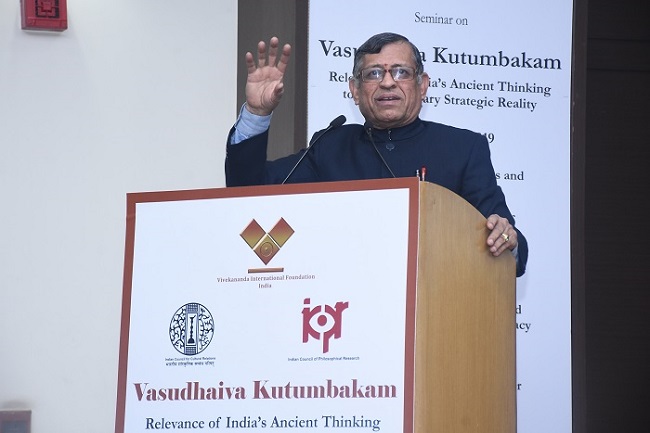
The Keynote Speaker on the second day was Shri S. Gurumurthy. He reminded us that Vasudhaiva Kutumbakam, in order to be effective in International Diplomacy, has to be a reciprocal virtue. Vasudhaiva Kutumbakam is undoubtedly an important, and that is why it appears in so many ancient texts. However, a strategic think tank’s approach to the issue will be different from that of a religious or spiritual organization. There are a few challenges we face when it comes to the use of Vasudhaiva Kutumbakam in International Relations. Firstly, we have to encounter ideological approaches, which are by nature different from philosophical approaches. Ideologies are exclusive and based on the attitude: “I am right, you are wrong.” The philosophical approach is that of “also”: “I am right, you may also be right.” Secondly, hard power of nation-states is a big challenge to the idea of Vasudhaiva Kutumbakam, which is based on the principle of self-restraint. India can provide the principle or the software of everlasting peace to the world, but the rest of the world has to accept the principle. If the principle of reciprocity is not kept in mind then an ideal like Vasudhaiva Kutumbakam, which is our greatest strength, can turn into our greatest weakness. He gave an example of reciprocity from Indian history: When the Parsi community was given shelter in India, they decided to stay in this land, just as sugar mixed with milk, only adding sweetness in gratitude. Sh Gurumurthy then went on to elaborate the history of war in India. He said that the ancient texts mention three kinds of victory: dharmavijaya, lobhavijaya, asuravijaya. The last kind of victory never happened in India before the thirteenth century, and Kautilya was criticized because he approved of the second kind of victory. Prithviraj Chauhan defeated Mohammad Ghori 18 times, but never killed him, while Ghori got him killed at the first opportunity. This speaks volumes about the Indian attitude in war. However, this does not mean that we are great, so anybody can do anything to us.

The next session focused on the implications of Vasudhaiva Kutumbakam for International Relations. In her presentation, Dr. Deepshikha Shahi, explored if Advaita Vedanta or non-dualism, which is the basis of Vasudhaiva Kutumbakam, can provide an alternative framework for International Relations theory which is so far based on a Western dualist epistemological approach. Prof. Sujit Dutta dealt with the real challenges of implementing the philosophy of Vasudhaiva Kutumbakam in International Politics. He pointed out that the political world puts forth a completely different set of challenges, such as scarcity of human resources, and unequal structure of power, and so on, which do not allow the actual practice of many principles. How can the Vasudhaiva Kutumbakam model work in a context like a conflictual notion of power struggle? Reciprocity must be the basis of Vasudhaiva Kutumbakam if it has to succeed as foreign policy.
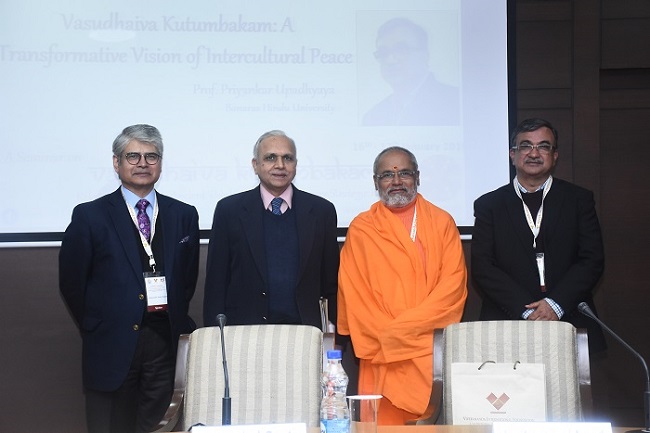
The following session dealt with Vasudhaiva Kutumbakam and its implications for India’s soft power. Swami Paramatmananda ji, Secretary General & Coordinator of Hindu Dharma Acharya Sabha, spoke about the nature of Indian culture. Today in the name of freedom of expression, Indians demonize their own culture. But Indian culture is such that it declared the world is not bhogya (object of enjoyment), but pujya (object of worship). He said that out ‘Namaste’ itself is the best expression of Vasudhaiva Kutumbakam. Marriage in Indian culture is not an end in itself, it is a means to an end. It is an institution meant for personal growth. Making a family calls for a lot of acceptance of the other person. Culture is something that addresses the basic needs of every individual. And the one common basic need of every individual is – “I want to be happy”.
In his talk, Amb Asoke Mukerji evaluated India’s contribution to international cultural diplomacy in the last hundred years. India was one of the members of the League of Nations and a signatory to the Treaty of Versailles signed in 1919 with the objective of preventing future war. Amb Mukerji then traced the long history of India’s involvement in international intellectual and cultural cooperation and the role of great Indian stalwarts such as Tagore, Acharya J C Bose, Prof. D N Banerji and others, till our times when India’s proposal for the adoption of International Day of Yoga came at the crest of several developments. Amb Mukerji also proposed that India could now become a world leader in intellectual cooperation and propose to set up and lead an international committee such as the International Committee on Intellectual Cooperation which was set up in 1922 and which later became the UNESCO. Prof. Priyankar Upadhyaya of the Benaras Hindu University (BHU) talked about how Vasudhaiava Kutumbakam can provide a framework for an indigenous approach to peace. He highlighted how many ideas which have gained international credence, such as ‘structural violence’, ‘deep ecology’ and so on, were of Indian origin. But these were not only borrowed, but also packaged in a certain way. Prof. Upadhyaya said how India had a holistic notion of peace—planetary peace, global peace, and so on. He also said that if we have to make a dent on international diplomacy, we also need to know about parallel concepts in other cultures. For example, the South African concept of Ubuntu (I am because we are) is similar to the Indian maxim of Vasudhaiva Kutumbakam. Prof. Upadhyaya also spoke about other Indian concepts such as the Jain concept of pluralism, Anekantavada.
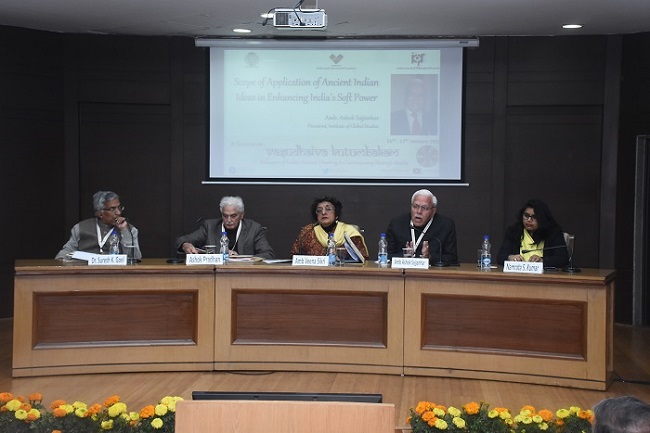
The seminar was wound up with a Round Table where senior diplomats and bureaucrats discussed how to apply ancient Indian ideas for enhancing India’s soft power. This session was chaired by Amb Veena Sikri and other participants were Dr. Suresh Goel, Former DG, ICCR, Shri Ashok Pradhan, Director, Bharatiya Vidya Bhavan, Amb Ashok Sajjanhar, and Ms. Namrata Kumar, DDG, ICCR. Some of the key points that emerged in the course of the Round Table were the following: The MEA has to, first all, take soft power seriously as a component of India strategic asset; the Indian Chairs and cultural centres abroad have to be more active in a meaningful way; since there is little discord over environmental issues, the importance of ancient Indian ideas for safeguarding the environment should be systematically highlighted; and so on.
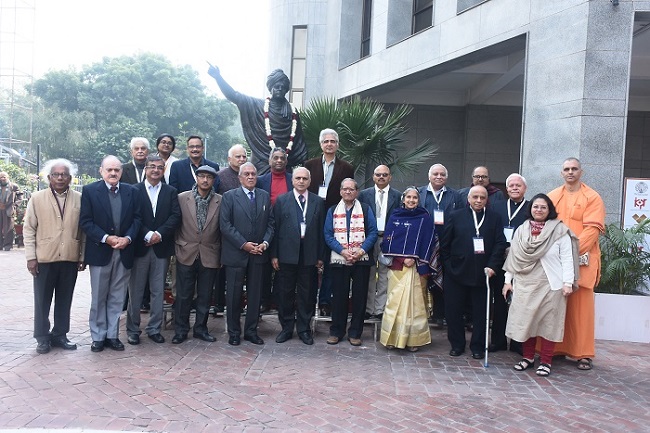




Post new comment